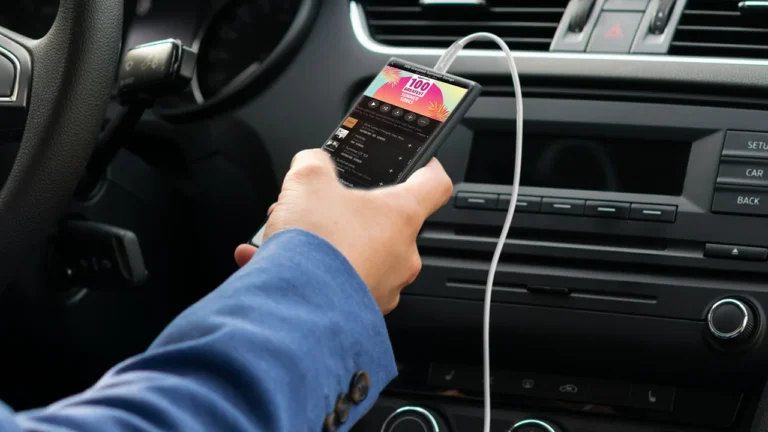Aux Cable to Car, In the age of smartphones and portable music players, many car owners look for easy ways to play their favorite tunes on the go. One of the simplest and most effective solutions is using an auxiliary (aux) cable to connect your device directly to your car’s sound system. Whether you have a smartphone, MP3 player, or tablet, an aux cable allows you to enjoy high-quality sound without relying on wireless connections or complicated setups.
1. What Is an Aux Cable?
An aux cable is a basic audio cable with a 3.5mm jack on both ends, similar to the connector found on most standard headphones. One end plugs into the headphone or audio output jack of your device, and the other plugs into your car’s aux input, usually located on the dashboard, stereo system, or center console.
Aux cables are versatile, affordable, and widely available. They provide a direct wired connection between your device and your car’s sound system, ensuring stable audio transmission without any interruptions or lag, making them a popular choice for music lovers who prefer a straightforward solution.
2. How to Connect an Aux Cable to Your Car
Connecting an aux cable to your car is quick and easy. Here’s a step-by-step guide:
- Locate the Aux Input: Most modern cars have an aux input jack near the car stereo or in the center console. If you’re unsure, consult your car’s manual to find the exact location.
- Plug in the Cable: Insert one end of the aux cable into your device’s headphone jack and the other end into the car’s aux input.
- Set the Stereo to Aux Mode: Once the cable is plugged in, set your car stereo to “Aux” mode. You may need to navigate through the input options on your car’s sound system to select it.
- Play Your Music: Now, play any audio from your device, and the sound will come through your car’s speakers. You can adjust the volume from both your device and the car stereo for the best sound quality.
3. Benefits of Using an Aux Cable
Using an aux cable offers several advantages for drivers and passengers who want to enjoy their own music in the car:
- High-Quality Audio: Since the aux cable transmits audio via a wired connection, you’ll experience minimal interference and clear sound quality, making it a great option for audiophiles.
- No Battery Drain: Unlike Bluetooth, which consumes battery power from your device, an aux cable doesn’t require any additional power, so you can listen to music for hours without worrying about draining your phone or music player’s battery.
- Universal Compatibility: Almost all smartphones, MP3 players, and other portable devices come with a standard 3.5mm headphone jack, so you can easily connect your favorite devices.
- Affordability: Aux cables are relatively inexpensive compared to other options like Bluetooth adapters or FM transmitters, making them a cost-effective solution for upgrading your car’s audio experience.
4. Limitations of Aux Cables
While aux cables provide a simple and reliable way to connect your device to your car’s stereo, there are a few drawbacks to consider:
- Lack of Wireless Connectivity: Unlike Bluetooth, aux cables require a physical connection, meaning your device has to stay plugged in during use, which can limit mobility or create clutter with dangling wires.
- No Hands-Free Calling: If you use your smartphone for calls while driving, an aux cable won’t provide hands-free functionality. Bluetooth or speakerphone would be better suited for this.
- Device Compatibility: Some newer smartphones, like many iPhone models, no longer come with a headphone jack. In this case, you may need an adapter (e.g., Lightning to 3.5mm) to connect the aux cable.
5. Alternative Options to Aux Cables
If you’re looking for alternative ways to connect your device to your car’s sound system, there are a few other options worth considering:
- Bluetooth Connection: Many modern cars come with built-in Bluetooth capabilities, allowing you to wirelessly stream music from your smartphone. If your car doesn’t have Bluetooth, you can use a Bluetooth adapter or transmitter.
- FM Transmitters: An FM transmitter broadcasts your device’s audio signal to a specific radio frequency that your car’s radio can pick up. This is a wireless option, but it can sometimes suffer from interference, especially in areas with many radio stations.
- USB Connection: If your car is equipped with a USB port, you can use a USB cable to link your device. This method can often charge your device while playing audio, though it may require your car stereo to be compatible with digital audio inputs.
6. Choosing the Right Aux Cable
When selecting an aux cable, look for one that is durable and provides good sound quality:
- Length: Choose a cable that’s long enough to reach from your device to the car’s aux input without being too long and creating unnecessary clutter.
- Material: Opt for a cable with high-quality shielding to prevent interference and ensure a clear audio signal. Some cables also have braided or reinforced designs for added durability.
- Gold-Plated Connectors: These connectors can improve the quality of the connection and reduce corrosion over time, ensuring a longer lifespan for your aux cable.
Conclusion
Connecting your device to your car’s sound system via an aux cable is one of the simplest and most reliable ways to enjoy your music on the road. With its ease of use, universal compatibility, and clear sound quality, the aux cable is a go-to solution for drivers who want a hassle-free audio experience. While wireless options like Bluetooth may offer more convenience, the aux cable remains a trusted and cost-effective option for playing music from your devices.
Read Also : Axkid Car Seat: A Guide to Safety, Comfort, and Innovation



